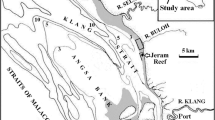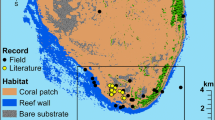Abstract
The relationship between characteristics of the reef environment and variations in the distribution and abundance of the anemonefishes Amphiprion akindynos and A. latezonatus was investigated at North Solitary Island, a sub-tropical rocky reef system on the east coast of Australia. During the summers of 1994 and 1995, fish densities and host sea-anemone cover were assessed on replicate 25 m transects at sites where host sea-anemones form semi-contiguous mats throughout the 6–21 m depth range. Multiple regression analyses indicated that environmental variables accounted for 65–71% and 61–80% of the variations in the number of A. akindynos and A. latezonatus among-sites, respectively. Among-habitat comparisons indicated that A. latezonatus densities were positively correlated with depth (r=0.45–0.90), whereas A. akindynos showed no consistent depth-related abundance patterns. Poor correlations (p>0.05) between the densities of each species on transect lines suggested that present-day competition was unlikely to determine the preference of A. latezonatus for deeper depths. Correlations between host sea-anemone cover and fish densities at the within-habitat (depth) scale were comparatively stronger than correlations at among-habitats in both species. These results suggest that among-habitat comparisons can confound finer scale fish-habitat associations within habitat (depth) zones. Evidence suggests that while sea-anemone cover does, to an extent, regulate the local ecology of anemonefishes, other factors are also likely to interact to limit their densities.
Similar content being viewed by others
References cited
Allen, G.R. 1975. Anemonefishes, their biology and classification. T.F.H. Publications, Neptune City. 352 pp.
Bell, J.D. & R. Galzin. 1984. Influence of live coral cover on coral-reef fish communities. Mar. Ecol. Prog. Ser. 15: 265-274.
Bell, J.D., M. Harmelin-Vivien & R. Galzin. 1985. Large scale spatial variation in abundance of butterflyfishes (Chaetodontidae) on Polynesian reefs. Proc. Int. Coral Reef Symp 5: 421-426.
Elliott, J.K. 1992. Factors influencing the distribution, abundance, and host specificity patterns of anemonefishes. Ph.D. Thesis, Florida State University, Tallahassee. 227 pp.
Fautin, D.G. 1992. Anemonefish recruitment: the roles of order and chance. Symbiosis 14: 143-160.
Fricke, H.W. 1979. Mating system, resource defence and sex change in the anemonefish Amphiprion akallopisos. Z. Tierpsychologie 50: 313-326.
Hattori, A. 1991. Socially controlled growth and size-dependent sex change in the anemonefish Amphiprion frenatus in Okinawa, Japan. Japan J. Ichthyol. 38: 165-177.
Hixon, M.A. 1980. Competitive interactions between California reef fishes of the genus Embiotoca. Ecology 61: 918-931.
Holbrook, S.J., R.J. Schmitt & R.F. Ambrose. 1991. Biogenic habitat structure and characteristics of temperate reef fish assemblages. Aust. J. Ecol. 6: 489-503.
Holbrook, S.J., S.L. Swarbrick, R.J. Schmitt & R.F. Ambrose. 1992. Reef architecture and reef fish: correlations of population densities with attributes of subtidal rocky environments. Proc. Int. Temperate Reef Symp. 2: 99-106.
Jennings, S., D. Boulle & N.V.C. Polunin. 1996. Habitat correlates of the distribution and biomass of Seychelles reef fishes. Env. Biol. Fish. 46: 15-25.
Jones, G.P. 1991. Postrecruitment processes in the ecology of coral reef fish populations: a multifactorial perspective. pp. 294-330. In: P.F. Sale (ed.) The Ecology of Fishes on Coral Reefs, Academic Press, San Diego.
Jones, G.P. & C. Syms. 1998. Disturbance, habitat structure and the ecology of fishes on coral reefs. Aust. J. Ecol. 23: 287-297.
Larson, R.J. 1980. Competition, habitat selection, and the bathymetric segregation of two rockfish (Sebastes) species. Ecol. Monogr. 50: 221-239.
Ochi, H. 1985. Temporal patterns of breeding and larval settlement in a temperate population of the tropical anemonefish, Amphiprion clarkii. Japan. J. Ichthyol. 32: 248-257.
Ochi, H. 1989. Acquisition of breeding space by nonbreeders in the anemonefish Amphiprion clarkii in temperate waters of southern Japan. Ethology 83: 279-294.
Moyer, J.T. & C.E. Sawyers. 1973. Territorial behavior of the anemonefish Amphiprion xanthurus with notes on the life history. Japan. J. Ichthyol. 20: 85-93.
Richardson, D.L. 1996. Aspects of the ecology of anemonefishes (Pomacentridae: Amphiprion) and giant sea-anemones (Actiniaria) within sub-tropical eastern Australian waters. Ph.D. Thesis, Southern Cross University, Lismore. 200 pp.
Richardson, D.L., V.J. Harriott & P.L. Harrison. 1997a. Distribution and abundance of giant sea-anemones (Actiniaria) in sub-tropical Eastern Australian waters. Mar. Freshw. Res. 48: 59-66.
Richardson, D.L., P.L. Harrison & V.J. Harriott. 1997b. Timing of spawning and fecundity of a tropical and a sub-tropical anemonefish (Pomacentridae: Amphiprion) at a high latitude reef on the east coast of Australia. Mar. Ecol. Prog. Ser. 156: 75-81.
Roberts, C.M. & R.F.G. Ormond. 1987. Habitat complexity and coral reef fish diversity and abundance on Red Sea fringing reefs. Mar. Ecol. Prog. Ser. 41: 1-8.
Ross, R.M. 1978. Territorial behavior and ecology of the anemonefish Amphiprion melanopus on Guam. Z. Tierpsychologie 36: 71-83.
Sale, P.F., J.A. Guy & W.J. Steel. 1994. Ecological structure of assemblages of coral reef fishes on isolated patch reefs. Oecologia 98: 83-99.
Sokal, R.R. & F.J. Rohlf. 1995. Biometry. W.H. Freeman & Co., New York. 887 pp.
Wilkins, H.K.A. & A.A. Myers. 1992. Microhabitat utilisation by an assemblage of temperate Godiidae (Pisces: Teleostei). Mar. Ecol. Prog. Ser. 90: 103-112.
Author information
Authors and Affiliations
Rights and permissions
About this article
Cite this article
Richardson, D.L. Correlates of Environmental Variables with Patterns in the Distribution and Abundance of Two Anemonefishes (Pomacentridae: Amphiprion) on an Eastern Australian Sub-tropical Reef System. Environmental Biology of Fishes 55, 255–263 (1999). https://doi.org/10.1023/A:1007596330476
Issue Date:
DOI: https://doi.org/10.1023/A:1007596330476




